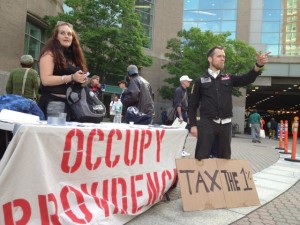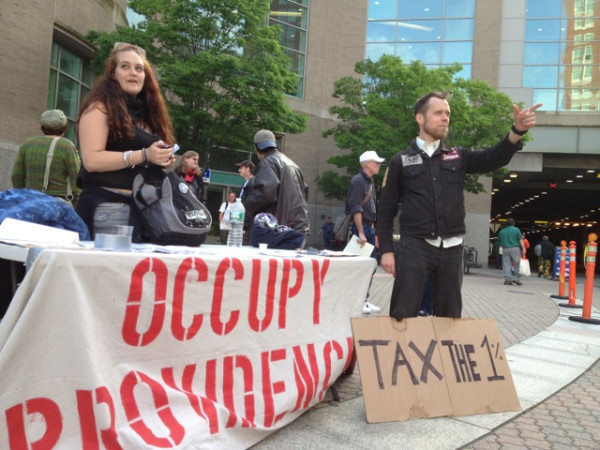
I was arrested while walking through a park at the Republican National Convention in St. Paul, Minnesota four years ago. Along with many other alarmed citizens, I was charged with Felony Riot and taken to Ramsey County Jail. With the support of Minneapolis Hip Hop group Atmosphere and the Rhode Island music label Strange Famous Records, I was bonded out of jail and then hired a private attorney.
We beat the case handily and all charges were dropped.
Police arrested over 800 people in four days at the RNC 2008. Many of us believed this was not only unlawful but an intentional effort to suppress citizen voices of dissent at the convention. So we filed a civil suit and took the City to Federal Court for violating our First and Fourth Amendment Rights. After four years of fighting the case is now over.
In 2010, with trial set for a month away, our first judge granted the City a summary judgement and threw the case out. Along with our attorney, my fellow arrestees and I found this unacceptable. We felt it was our civic and patriotic duty to pursue justice and continue doing anything in our legal power to make sure that these violations didn’t go unchecked. Together, we then appealed to the 8th Circuit Court of Appeals but ran up against a very conservative judge who said that the police should be “praised for their work at the RNC, not sued.”
Having come this far, and being unwilling to give up till all possibilities were exhausted, we took the case to the highest court in the land. In November of 2012, after examining our case and the previous decisions, the Supreme Court chose not to hear the appeal.
There are no legal options left and my comrades and I are satisfied that we defended ourselves and the constitution to the best of our ability. After an arbitrary, mass arrest, we were given trumped up charges and threatened with harsh penalties in hopes that we would accept a plea deal for actions we weren’t guilty of, but we didn’t take any plea. From my vantage point, this is not a defeat, it’s a clear victory.
We beat the city fair and square, and then we went on the offensive. We refused to allow the City to break the law without impunity. We took them to court. And then appealed to a higher court each time we were brushed off. If all working class defendants had the proper counsel, time, resources, and support to fight all the way through the Trial and Appeals process it’d be significantly harder for police and prosecutors to wrongfully arrest and jail people.
I for one am more than happy to have been a thorn in their side for the past four years and to be part of the recent rising trend of working class people learning their rights, getting help, and fighting back.
My attorney drafted a letter to multiple Minneapolis publications in December and January. It was never published. I’ve now been given permission to make the letter public. His insightful and eloquent words are posted below.
AN UNFORTUNATE LEGACY OF THE 2008 RNC
The City of St. Paul hosted the Republican National Convention four years ago, and most Minnesotans are likely relieved that it is behind us. But there is a legacy from the RNC that most Minnesotans are not aware of. Last fall, the United States Supreme Court signed off on a decision from the Eighth Circuit Court of Appeals in a mass arrest case arising out of the RNC. That decision in Bernini v. St. Paul diminishes the Fourth Amendment rights of all citizens attending public events.
The Bernini case carved out an exception to the Fourth Amendment to allow officers during demonstrations to arrest every single person in an area for the purpose of identifying alleged lawbreakers. This exception undermines the bedrock principal enunciated by the Supreme Court over thirty years ago in Ybarra v. Illinois that probable cause for an arrest cannot be based merely on “where [a] person may happen to be.”
The facts of the late afternoon mass arrest on September 1, 2008 are as follows: the incident location was Shepard Road, the boulevard that borders the Mississippi next to downtown St. Paul. A group of 10 to 15 protesters attempted to cross Shepard toward Jackson St., an entry point into downtown. Stationed at the entry to Jackson was a law enforcement unit in riot garb.
What happened next was captured on video and has been posted publicly on the internet. The small group shuffled slowly behind two signs. When the small group reached the median of Shepard, the officers launched stinger blast balls at them, followed by smoke and gas. The officers claimed that the group had attacked them with a barrage of rocks, urine, and feces. The video showed no such attack.
Over one hundred officers massed on Shepard and pushed all civilians in the area west, away from downtown. Law enforcement commanders had set up a “blocking line” further to the west on Shepard to corral all civilians being pushed towards them. In carrying out this corral, officers swept up people who had nothing to do with the protesters and those who had been nowhere near Jackson.
Upon completing the corral next to the Mississippi, officers had surrounded approximately 400 confused, peaceful civilians. Officers then announced by loudspeaker, “Ladies and Gentlemen, you are now under arrest.” There was one, huge problem: officers only claimed to have probable cause to believe that a small percentage of the 400 arrested had committed a crime.
The Senior Commander that day was well aware of this probable cause shortcoming and so admitted when testifying in Bernini:
Q. [D]id you know that some of the people who were going to be arrested, you did not have probable cause on?
A. Yes, sir.
Q. [Y]ou knew that you had approximately 200 people in the area within the encirclement who you did not have probable cause on?
A. Correct.
So how is it that the courts gave their imprimatur to the arrests of at least 200 innocent civilians? First, the District Court Judge took offense that throngs of people sought to disturb the RNC. He could not contain his displeasure and declared in open court, “the police force of the City of St. Paul should be commended and not sued… I’m distressed by, frankly, the existence of this case.” So much for the Fourth Amendment.
The Eighth Circuit Court of Appeals, the court that reviewed the District Court decision, assumed that everyone who was released after being put under arrest
wasn’t really “arrested” and thus had no Fourth Amendment protection. The judges then engaged in the fuzziest of math, to arrive at the proposition that officers can use rough numbers when arresting civilians. Otherwise put, civilians in any given area are interchangeable widgets for arrest purposes. As long as officers arrive at a reasonable ballpark estimate for the number of people to arrest, their actions are constitutional.
Over forty years ago, the Supreme Court cautioned, “we cannot forgive the requirements of the Fourth Amendment in the name of law enforcement.” Bernini tells us the courts can – and have. -David L. Shulman

